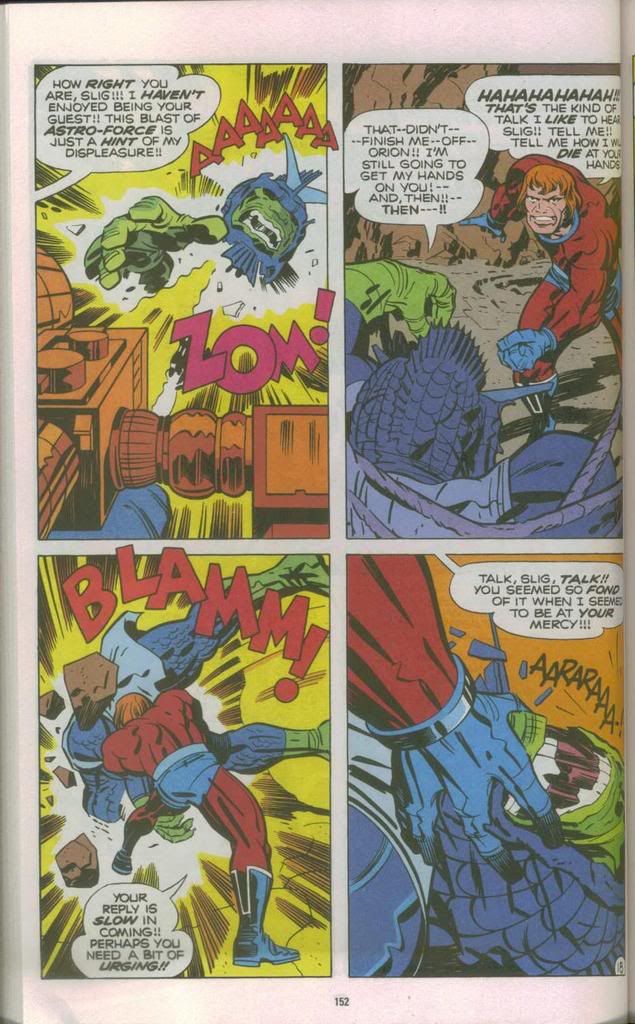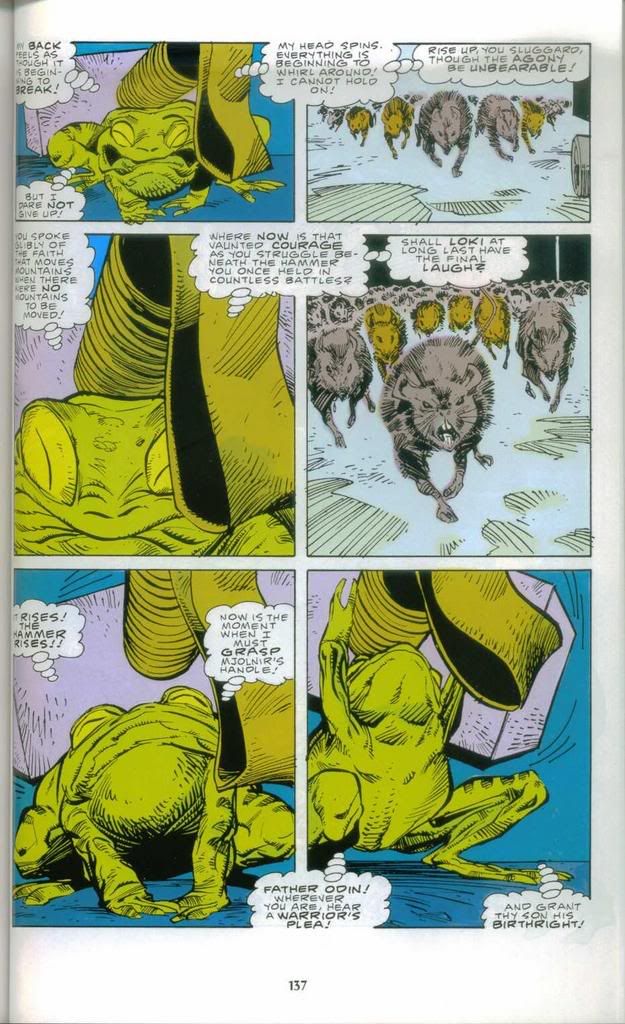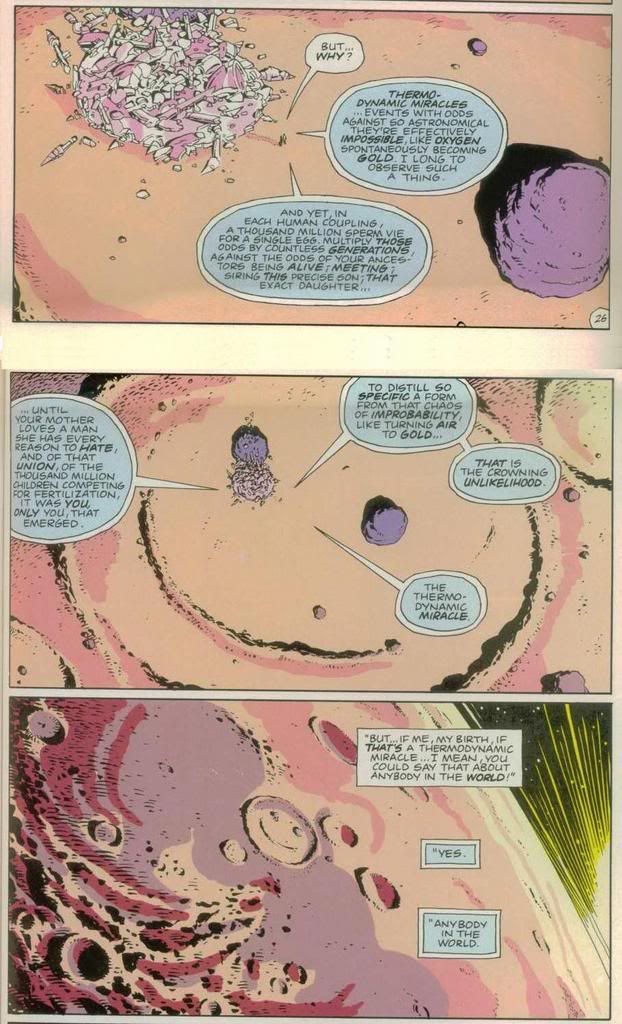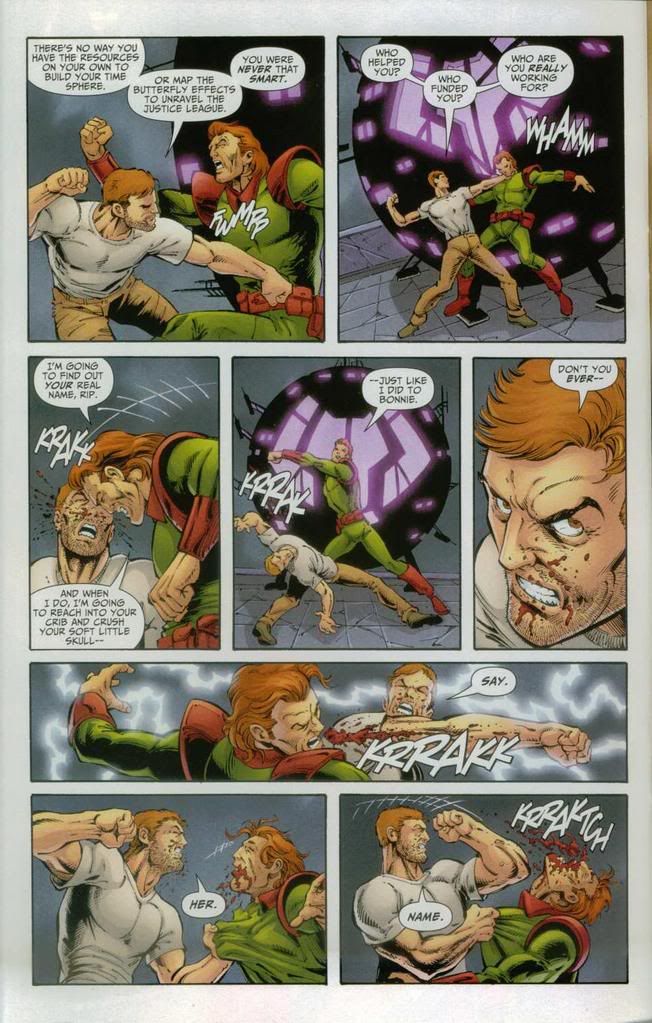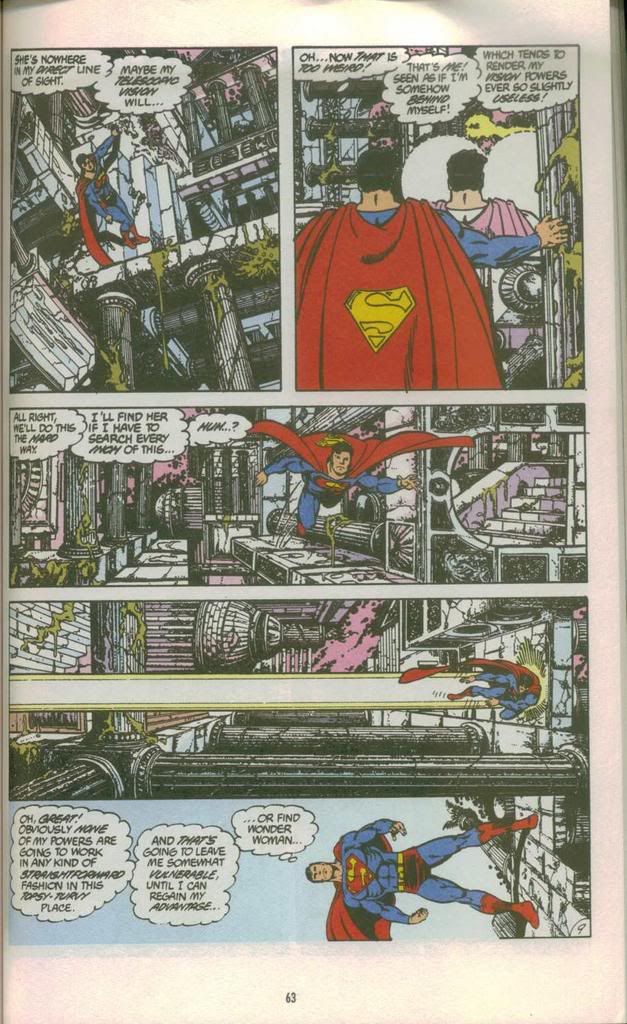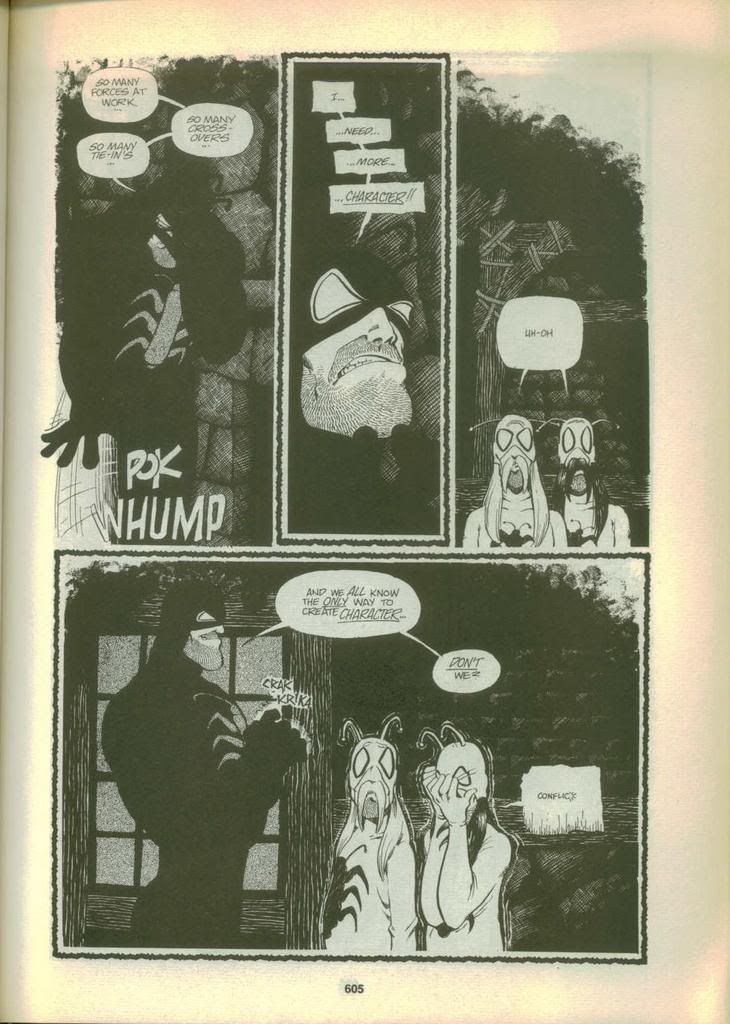... So I bought sixteen comic books and then entered a Nyquil fog? Isn't it supposed to happen the other way around?
Jeez, sixteen comics. I'll point out quickly, though, that three carry the Countdown banner, two the 52 Aftermath one, and a couple of others are one-shots (Green Lantern Secret Files, Fantastic Four Isla de la Muerte), and one I'm just giving a tryout to (LSH). So that's half, which makes me feel a little better.
Also, I read 'em last night during the Nyquil haze, so I might still be a little fuzzy talking about 'em today.
Onward!
The three Countdown books -- Arena #4, C. To Adventure #5, and issue #18 of the main book -- were all pretty competently done. The big attraction in the main book was the reunion with Ray Palmer, but it felt more like the capper to those wheel-spinning Search For specials from the past few months. Good to check in with Ray, but not much else happened this week, and of course another cliffhanger ending. The Adventure book advanced the plot in San Diego, but seeing that we're past the halfway point and our three stalwarts haven't hooked up again, the story starts to look a little more padded. Finally, Arena wrapped up with a weird fight involving the Supermen, made even more incomprehensible by Christopher Kent (the bald one)'s odd powers. If you had "Superman defeats Monarch," you lost!
The Forerunner backup in C. To Adventure was okay, about her taking over a pirate ship and generally being hardcore, but the overall storyline has not engaged me.
Moving on. Green Lantern Sinestro Corps Secret Files & Origins #1 was surprisingly comprehensive as these things go, delivering on the cover's promise of "bios on over 200 Lanterns!" and generally acting as the Bill James Baseball Abstract 2008 for all us GL fans. Worth the $4.99, and I don't say that lightly about these Secret Files books.
Mark Waid strikes twice this week, first with Flash #235 and then with Brave and the Bold #9. The Flash story was fine; more intriguing for its Jai-Wally scenes than for any advancement in the plot. I'm not convinced that Freddie Williams is a good fit for this book. I might have mentioned already that his figures are a little on the bulky side, and for a speedster I don't think that's optimal. Still, it's not a total mismatch. The backup fares better, being a Wally-and-Bart flashback and helping to explain the origin of the main story's bad guy.
The Brave and the Bold #9 is likewise a patchwork of three fairly simple team-ups (Metal Men and Dial H For Hero, Blackhawk and Boy Commandos, present-day Atom and Hawkman) in which each set of heroes fights some messenger of Megistus. It's all tied together by a Challengers of the Unknown framing sequence, and the suggestion that the Book of Destiny has come to life somehow. (There must have been some magic in that old silk hat they found....) It will probably mean more to the story once the bigger picture is seen, and it's not the best issue so far, but it's still pretty fun.
This week also sees a double dose of the Legion of Super-Heroes, first in their own book and then in Action Comics. Legion #37 kicks off the return of Scripter-Boy Jim Shooter, back after thirty-plus years; and I've gotta say, I wasn't really encouraged. The thrust of the story is that new Legion leader Lightning Lad is, to put it lightly, overwhelmed by his responsibilities, with the team suffering as a result. The issue provides an overview of quite a few Legionnaires, which is appropriate, and it's not really decompressed, which I appreciated; but it almost tries to do too much. Blocky, angular art from penciller Francis Manapul and inker Livesay doesn't help the scenes flow into one another. There's also not much sense that this Legion is appreciably different from the old Shooter/Levitz days, and I kinda think there should be. Maybe I'm just picky that way.
Over in Action Comics #860, what is allegedly the old Shooter/Levitz Legion gets its own workout, but again, the book just feels crowded with characters. Having them all introduced with their own bullet-point caption is a nice idea in theory, but in practice -- take the first page, for example -- the things can clutter up the page. The Legionnaires also crowd out Superman themselves, but if the point is to get all the players straight before the big scrum, that'd make it easier to take. Oddly enough, I think penciller Gary Frank makes the Legionnaires look a little older than Superman, which strikes me as an intriguing detail if it's intentional. Look at the cheekbones on Lightning Lass and Night Girl. Those faces seem almost middle-aged to me. Anyway, we're about where I'd expect for the halfway point of the story, so it's still good thus far.
Green Lantern #26 bills itself as Part 1 of "The Alpha Lanterns," but it's more transitory than that. Pieces are picked up after the Sinestro Corps War, Hal and John go back to Earth, and a group of "Lost Lanterns" runs afoul of Amon Sur. Mike McKone comes on as penciller and does a good job. His layouts aren't as crowded as Ivan Reis's, but of course he's not drawing thousands of GLs and Sinestros either. Because the issue is so episodic, it's hard to get a sense of what it wants to accomplish, and it dispenses with the "Alpha Lantern" thing pretty quickly. We'll see how Part 2 deals with the Alphas, I guess.
Another somewhat transitory issue was Captain America #33, wherein the Winter Soldier's arm beats up some SHIELD techs and the fully-armed (ha ha) W.S. almost takes out Iron Man. Pieces are put together by the good guys re: the involvement of the Red Skull, and next issue advertises the New Cap. Another fine installment.
Fantastic Four: Isla De La Muerte was a cute one-shot spotlighting the Thing's annual secret vacation to Puerto Rico. With as much time spent on team dynamics as on the mystery du jour, it's a good little FF story. I don't quite see the resemblance between Ben and El Morro, though. The art, by Juan Doe, is fairly cartoony, but I just say that to describe, not criticize.
JLA Classified #49 was a strange, rather insubstantial story about the Leaguers' various helpmates reacting to their being off-planet on a dangerous mission. Most of it concerns Lois Lane and Alfred Pennyworth meeting for the first time, which you'd think would place this fairly early in DC history; but Wally is the Flash and Linda is his sweetie, so it can't be that old. Also, Lois either doesn't know Superman's secret, or doesn't know that she can share it with Alfred. Paulo Siqueira and Amilton Santos are the penciller and inker, respectively, and they combine to produce somewhat Adam Hughes-like figures. However, the layouts are a little too self-conscious, with figures jumping out of panels when they maybe really shouldn't. The overall effect is to make the story seem more important than it is. I hate to be a continuity stickler, but it might've worked better with a more open relationship among the principals; and that might've been better portrayed with a group which included the Silver Age significant others. Those people did hang out together in a way that, say, Alfred and Lois don't.
Teen Titans #54 finished up the "Titans Of Tomorrow Today" storyline, but I'm not sure how. Did the revelations about Future-Kon and Future-Bart really affect the current Titans' viewpoints enough that history will be changed for the better? And what about that epilogue? The issue has some nice moments, many of them involving Wonder Girl or Blue Beetle, but I don't know that they add up to a coherent conclusion.
Batman #672 sees Grant Morrison and Tony Daniel return to the familar "Three Evil Batmen" storyline Morrison had been working before the Club of Heroes and Ra's al Ghul arcs intervened. I liked this issue pretty well, although I thought the ending was confusing. Since it involved Zur-En-Arrh, a Batman getting shot, and what looks like Bat-Mite, I'm sure it'll be explained eventually. Daniel and his various inkers still remind me of Andy Kubert, but that may well be the influence of Guy Major's colors.
Finally, the two 52 spinoffs, Four Horsemen and Crime Bible, were both pretty entertaining. I especially liked Crime Bible's look at the Gotham PD and, therefore, Greg Rucka's "return" to Gotham Central territory. Batwoman also seemed a lot more plausible as a crimefighter, although you'd think we'd have seen her in more places even taking her recovery into account. Anyway, Crime Bible was more a spotlight on the Question's relationship to Batwoman, and for that it was pretty good.
Four Horsemen continues to be a good adventure story, weaving various ancillary characters like Mr. Terrific, Veronica Cale, and Snapper Carr into its story about DC's "Big Three" taking on Apokoliptian terror-gods. This issue adds the Doom Patrol. It's all very well-organized, with enough set pieces (like Superman's and Batman's respective duels with Horsemen) to hold my interest. Of course, there's not much doubt about the outcome, so the fun is in seeing how we'll get there.
Whew! How's that for a whirlwind look at an end-of-year blowout week?
* * *
CREDITS
Action Comics #860. Written by Geoff Johns, pencilled by Gary Frank, inked by Jon Sibal, colored by Dave McCaig.
Batman #672. Written by Grant Morrison, pencilled by Tony Daniel, inked by Daniel, Jonathan Glapion, and others, colored by Guy Major.
The Brave and the Bold #9. Written by Mark Waid, pencilled by George Pérez, inked by Bob Wiacek and Scott Koblish, colored by Tom Smith.
Captain America #33. Written by Ed Brubaker, pencilled by Steve Epting, inked by Butch Guice, colored by Frank D’Armata.
Countdown Arena #4. Written by Keith Champagne, pencilled by Scott McDaniel, inked by Andy Owens, and colored by Guy Major.
Countdown To Adventure #5. “Space Heroes” written by Adam Beechen, pencilled by Allan Goldman, inked by Julio Ferreira, and colored by The Hories. “Forerunner” written by Justin Gray, pencilled by Fabrizio Fiorentino, inked by Adam DeKraker, and colored by The Hories.
Countdown (To Final Crisis) #18. Written by Paul Dini and Sean McKeever, story consultant Keith Giffen, drawn by Scott Kolins, colored by Tom Chu.
Fantastic Four: Isla de la Muerte! #1. Written by Tom Beland, drawn and colored by Juan Doe.
52 Aftermath: Crime Bible -- Five Lessons Of Blood #3. Written by Greg Rucka, drawn by Matthew Clark, colored by Javier Mena.
52 Aftermath: The Four Horsemen #5. Written by Keith Giffen, pencilled by Pat Olliffe, inked by John Stanisci, colored by Hi-Fi.
The Flash #235. Main story written by Mark Waid, drawn by Freddie Williams II, and colored by Tanya & Richard Horie. Backup written by Waid and John Rogers, drawn by Doug Braithwaite, and colored by Alex Sinclair.
Green Lantern #26. Written by Geoff Johns, pencilled by Mike McKone, inked by Andy Lanning, Marlo Alquiza, & Cam Smith, and colored by JD Smith.
Green Lantern Sinestro Corps Secret Files & Origins #1. Written, drawn, and colored by too many people to mention.
JLA Classified #49. Written by Andrew Kreisberg, pencilled by Paulo Siquiera, inked by Amilton Santos, and colored by Allen Passalaqua.
Legion of Super-Heroes #37. Written by Jim Shooter, pencilled by Francis Manapul, inked by Livesay, and colored by Nathan Eyring.
Teen Titans #54. Written by Sean McKeever, pencilled by Eddy Barrows, Joe Prado, & Greg Tocchini, inked by Rob Hunter, Julio Ferreira, Oclair Albert, & Prado, and colored by Rod Reis.
Full Post
